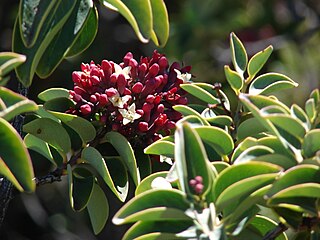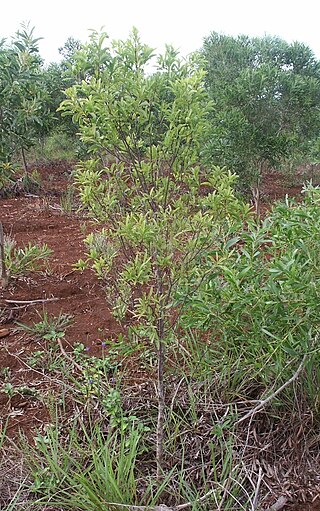
Sandalwood is a class of woods from trees in the genus Santalum. The woods are heavy, yellow, and fine-grained, and, unlike many other aromatic woods, they retain their fragrance for decades. Sandalwood oil is extracted from the woods for use. Sandalwood is often cited as one of the most expensive woods in the world. Both the wood and the oil produce a distinctive fragrance that has been highly valued for centuries. Consequently, some species of these slow-growing trees have suffered over-harvesting in the past.

Acacia koa or commonly known as koa is a species of flowering tree in the family Fabaceae. It is endemic to the Hawaiian Islands, where it is the second most common tree. The highest populations are on Hawaiʻi, Maui and Oʻahu.

Santalum is a genus of woody flowering plants in the Santalaceae family, the best known and commercially valuable of which is the Indian sandalwood tree, S. album. Members of the genus are trees or shrubs. Most are root parasites which photosynthesize their own food, but tap the roots of other species for water and inorganic nutrients. Several species, most notably S. album, produce highly aromatic wood, used for scents and perfumes and for herbal medicine. About 25 known species range across the Indomalayan, Australasian, and Oceanian realms, from India through Malesia to the Pacific Islands, as far as Hawaiʻi and the Juan Fernández Islands off the coast of South America.

Thespesia populnea, commonly known as the portia tree, Pacific rosewood, Indian tulip tree, or milo, among other names, is a species of flowering plant belonging to the mallow family, Malvaceae. It is a tree found commonly on coasts around the world. Although it is confirmed to be native only to the Old World tropics, other authorities consider it to have a wider, possibly pantropical native distribution. It is thought to be an invasive species in Florida and Brazil.

Hibiscus tiliaceus, commonly known as the sea hibiscus or coast cottonwood, is a species of flowering tree in the mallow family, Malvaceae, with a pantropical distribution along coastlines. It has also been introduced to Florida and New Zealand. It has been debated whether this species is native or introduced to Hawaii.

Metrosideros polymorpha, the ʻōhiʻa lehua, is a species of flowering evergreen tree in the myrtle family, Myrtaceae, that is endemic to the six largest islands of Hawaiʻi. It is a highly variable tree, being 20–25 m (66–82 ft) tall in favorable situations, and a much smaller prostrate shrub when growing in boggy soils or directly on basalt. It produces a brilliant display of flowers, made up of a mass of stamens, which can range from fiery red to yellow. Many native Hawaiian traditions refer to the tree and the forests it forms as sacred to Pele, the volcano goddess, and to Laka, the goddess of hula. ʻŌhiʻa trees grow easily on lava, and are usually the first plants to grow on new lava flows.

Acacia koaia, known as koaiʻa or koaiʻe in Hawaiian, is a species of acacia that is endemic to Hawaii. It is closely related to koa, and is sometimes considered to be the same species.

Santalum album, or Indian sandalwood, is a small tropical tree, and the traditional source of sandalwood oil. It is native to southern India and Southeast Asia. It is considered sacred in some religions like Hinduism, and some cultures place great significance on its fragrant qualities. However, the high value of the species has caused over-exploitation, to the point where the wild population is vulnerable to extinction. Indian sandalwood still commands high prices for its essential oil owing to its high alpha santalol content, but due to lack of sizable trees it is no longer used for fine woodworking as before. The plant is long-lived, but harvest is only viable after many years.

Mezoneuron kavaiense is a rare shrub or small tree in the genus Mezoneuron, that is endemic to Hawaii. Common names include Uhiuhi, Kāwaʻu (Maui), and Kea (Maui). It is threatened by invasive species, particularly feral ungulates.

Alphitonia ponderosa is a species of flowering tree in the family Rhamnaceae, that is endemic to the Hawaiian Islands. It is locally known as kauila, as is the related Colubrina oppositifolia.

Flueggea neowawraea, the mēhamehame, is a species of flowering tree in the family Phyllanthaceae, that is endemic to Hawaii. It can be found in dry, coastal mesic, and mixed mesic forests at elevations of 250 to 1,000 m. Associated plants include kukui, hame, ʻahakea, alaheʻe, olopua, hao, and aʻiaʻi. Mēhamehame was one of the largest trees in Hawaiʻi, reaching a height of 30 m (98 ft) and trunk diameter of 2 m (6.6 ft). Native Hawaiians used the extremely hard wood of this tree to make weaponry.

Santalum haleakalae, known as Haleakala sandalwood or ʻIliahi in Hawaiian, is a species of flowering tree in the sandalwood family, that is endemic to the islands of Maui, Lanai, and Molokai in the Hawaiian Islands, part of the United States. It grows in subalpine shrublands at elevations of 1,900 to 2,700 m, especially on the slopes of Haleakalā.

Myoporum sandwicense, commonly known as naio, bastard sandalwood or false sandalwood is a species of flowering plant in the figwort family, Scrophulariaceae. It is a tree or shrub highly variable in its form, the size and shape of its leaves, in the number of flowers in a group and in the shape of its fruit. It is endemic to Hawaiʻi.

Santalum freycinetianum, the forest sandalwood, Freycinet sandalwood, or ʻIliahi, is a species of flowering tree in the European mistletoe family, Santalaceae, that is endemic to the Hawaiian Islands. Its binomial name commemorates Henri Louis Claude de Saulces de Freycinet, a 19th-century French explorer. ʻIliahi inhabits dry, coastal mesic, mixed mesic, and wet forests on Oʻahu, Kauaʻi, Lānaʻi, Maui, and Molokaʻi at elevations of 250–950 m (820–3,120 ft). It grows in areas that receive 500–3,800 mm (20–150 in) of annual rainfall. Like other members of its genus, ʻiliahi is a root hemi-parasite, deriving some of its nutrients from the host plant; common hosts include koa, koaiʻa, and ʻaʻaliʻi.

Nestegis sandwicensis, commonly known as Hawai'i olive or olopua, is a species of flowering tree in the olive family, Oleaceae, that is endemic to Hawaii. It is found on all major islands at elevations of 30–1,300 m (98–4,265 ft) in coastal mesic and mixed mesic forests, and, especially, dry forests. It usually reaches a height of 6 m (20 ft) with a trunk diameter of 0.2 m (0.66 ft), but may reach 20 m (66 ft) in height with a trunk diameter of 0.9 m (3.0 ft).

Psydrax odorata, known as alaheʻe in Hawaiian, is a species of flowering shrub or small tree in the coffee family, Rubiaceae. It is native to the Pacific Islands, New Guinea and Australia.

Rhus sandwicensis, commonly known as neneleau, neleau or Hawaiian sumac, is a species of flowering plant in the cashew family, Anacardiaceae, that is endemic to Hawaii. It is small tree, reaching a height of 4.5–7.5 m (15–25 ft) and a trunk diameter of 10–30 cm (3.9–11.8 in). Neneleau inhabits dry, coastal mesic, mixed mesic and wet forests at elevations of 180–610 m (590–2,000 ft) on all main islands.

Santalum austrocaledonicum, or New Caledonia sandalwood, is a sandalwood tree from the family Santalaceae. It is a small tree with gray bark and green leaves, and is parasitic. Most have been removed from their habitat due to logging; very few trees remain in the wild.

Pouteria sandwicensis is a species of flowering tree in the sapodilla family, Sapotaceae, that is endemic to the main islands of Hawaii. Names for this species in the Hawaiian language include ʻĀlaʻa, Āulu and ʻĒlaʻa.

Leptecophylla tameiameiae, known as pūkiawe or maiele in the Hawaiian language, is a species of flowering plant that is native to the Hawaiian and Marquesas Islands. The specific epithet honors King Kamehameha I, who formed the Kingdom of Hawaiʻi. It grows as a tree up to 4.6 m (15 ft) tall in forests and as a shrub 0.9–3 m (3.0–9.8 ft) in height elsewhere. Its small needle-like leaves are whitish underneath, dark green above. The round berries range in color from white through shades of pink to red. Pūkiawe is found in a variety of habitats in Hawaii at elevations of 15–3,230 m (49–10,597 ft), including mixed mesic forests, wet forests, bogs, and alpine shrublands.




















